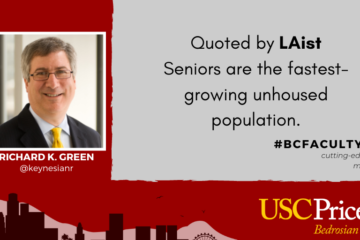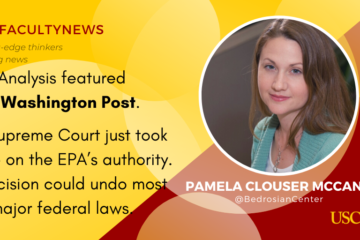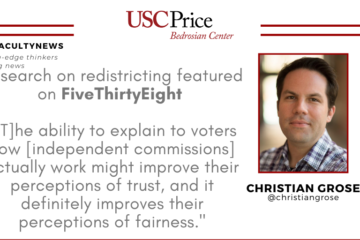Second Annual Conference brings interdisciplinary mix to Political Science study
On March 14th and 15th 2019, the USC Bedrosian Center’s Political Institutions and Political Economy (PIPE) Collaborative hosted its 2nd Annual Conference. Bringing together scholars from various disciplines such as political science, economics, and public policy the conference covered topics from the succession of rulers in autocratic Roman Empire to how the accumulation of zoning policies affect segregation in cities.
“The research presentations focus on the growth of legislative power, bureaucratic capacity, political budget cycles, the value of public office, foreign lobbying in Congress, and the determinants of individual voting behavior in the United States,” says Director Jeffery A. Jenkins.
The PIPE Collaborative and its annual conference provide scholars an opportunity to interact, which is critical given the cross-disciplinary nature of these topics. The conference fosters, as Jenkins says, “[the]synergies to be had by ensuring there are regular forums to bring together scholars from different research traditions who may not ordinarily talk to one another.”
While the Ides of March would not be until the next day, Thomas Gray (UT – Dallas) began the conference in Ancient Rome, looking at succession and stability. Arguing that autocratic rulers rely on a strongly connected network for succession to the throne, Gray saw evidence of advantages in nepotistic successors. Using novel data on the Roman Empire, he found that when a new ruler is closely connected with the prior one, their reign was longer and often more successful. Rejecting the idea that the past cannot contribute to understanding politics of today; Gray and his co-author say, “[c]onnectedness and centrality were important to Roman rulers just as they are important features in describing 20th and 21st century authoritarianism.”
Jumping to Colonial Peru, Jenny Guardado (Georgetown) said her research “provides evidence on how the sale of public offices undermined mechanisms of hierarchical oversight within the colonial government of Peru.” In an application of unique historical evidence, Guardado’s paper has implications for present day political institutions, as bribes for bureaucratic positions are observed in various countries. Moreover, the ability to purchase positions created a class of public officials improperly qualified to complete the duties of the offices they held.
Sean Gailmard (Berkeley) steered the conference forward through history, to the colonial United States. Gailmard’s presentation focused on the foundations and growth of legislative power between colonial governors and the British crown. Using a formal model, Gailmard found, “that the progressive growth of assembly power was rooted in strategic dilemmas of imperial governance, and more specifically in agency problems between the crown and governors.”
Pavi Suryanarayan (Johns Hopkins) began the afternoon panel presenting work co-authored with Steven White (Syracuse) exploring the political economy of taxation and economic inequality in Reconstruction Era United States. They found that Reconstruction ushered in higher taxation in counties that had greater concentrations of slaves prior to the Civil War. However, these counties saw lower taxes and bureaucratic capacities by the 1870s, after whites returned to power. In the end, their paper further supports theories from scholars in other fields “that there is also an institutional component to the persistent racial and economic conservatism of southern politics since 1877.”
Continuing on the political economic vein, Gergely Ujhelyi (Houston) explored political budget cycles and bureaucracies. Electoral cycles in government spending can often be a result of bureaucratic organization that incentivizes politicians. Looking at state highway spending, he found that budget cycles are more prevalent under patronage bureaucratic systems, while no budget cycles occur under civil service systems. Importantly, this paper concludes that “[b]ureaucratic institutions matter for policy and the behavior of politicians.”
The first day ended with a book talk by Jessica Trounstine (UC – Merced). Her book, Segregation by Design, pushes beyond the conventional wisdom in political science, maintaining that segregation differences across the United States were, and continue to be, grounded in local policy. Through a unique exploration of city zoning laws, she shows that zoning institutionalizes segregation as cities with more land regulations have more segregation. Taking this further, she argues that cities with more segregation experience more racially polarized elections, as well as underfunded public goods.
Day two of presentations began with economist Vincent Pons (Harvard and NBER). He analyzed voter behavior through the lens of contextual drivers (economic growth, voting rules, and media consumption) and individual drivers (like race and education). Separating voter turnout into state components and voter components, Pons “find[s] that state characteristics explain about 52 percent of the observed cross-state variation in turnout, and voter characteristics [explain] the residual 48 percent.”
Hye Young You (NYU) followed with a paper asking “[h]ow do lobbying strategies change as legislation advances, and do lobbying activities influence the voting behaviors of legislators?” With a novel dataset constructed from foreign lobbying reports, You presented evidence that the strategies lobbyists engage in depends on the legislative process. She suggests that lobbyists target leadership in Congress during the agenda-setting stage as well as members in tight election races during the floor voting stage. Consequently, You says “this article improves our understanding of the interaction between US policymakers and foreign governments.”
The 2nd Annual PIPE Conference closed with Andrew Hall (Stanford) asking “what types of citizens become politicians?” Hall and his co-authors analyze de-anonymized U.S. Census data from 1940 to explore the characteristics of individuals who become members of Congress. The results of this interesting paper argue that “[w]hile the American system evidently attracts highly educated individuals able to command high salaries in the private sector, the political class is drawn disproportionately from the wealthier and more educated swaths of society.”
Over the course of the conference presentations, one recurring theme was the developmental nature of institutions analysis. While a focus on political institutions and political economy in the contemporary era is important, an exclusive focus on the present can be limiting. Understanding how political institutions form and why political-economic decisions are made across time helps scholars understand why the modern institutions and political-economic arrangements look the way that they do. A historical focus also allows scholars to test contemporary theories in different ways and in different contexts, which lead to a richer array of empirical analyses.
Nathan K. Micatka is a PhD candidate in Political Science at the University of Southern California and inaugural PIPE Fellow with the USC Bedrosian Center at USC Price.



